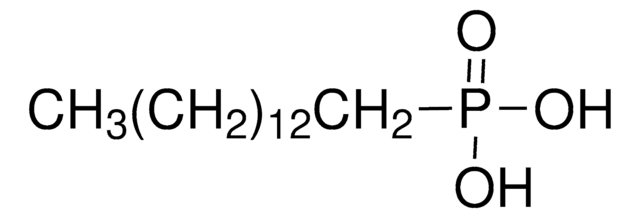736244
Hexadecylphosphonic acid
97%
Sinônimo(s):
n-Hexadecylphosphonic acid, HDPA
About This Item
Produtos recomendados
Nível de qualidade
Ensaio
97%
forma
solid
pf
88-93 °C
temperatura de armazenamento
2-8°C
cadeia de caracteres SMILES
CCCCCCCCCCCCCCCCP(O)(O)=O
InChI
1S/C16H35O3P/c1-2-3-4-5-6-7-8-9-10-11-12-13-14-15-16-20(17,18)19/h2-16H2,1H3,(H2,17,18,19)
chave InChI
JDPSFRXPDJVJMV-UHFFFAOYSA-N
Categorias relacionadas
Descrição geral
Aplicação
Código de classe de armazenamento
11 - Combustible Solids
Classe de risco de água (WGK)
WGK 3
Ponto de fulgor (°F)
Not applicable
Ponto de fulgor (°C)
Not applicable
Escolha uma das versões mais recentes:
Já possui este produto?
Encontre a documentação dos produtos que você adquiriu recentemente na biblioteca de documentos.
Os clientes também visualizaram
Artigos
There is widespread demand for thin, lightweight, and flexible electronic devices such as displays, sensors, actuators, and radio-frequency identification tags (RFIDs). Flexibility is necessary for scalability, portability, and mechanical robustness.
Self-assembled monolayers (SAMs) have attracted enormous interest for a wide variety of applications in micro- and nano-technology. In this article, we compare the benefits of three different classes of SAM systems (alkylthiolates on gold.
Nossa equipe de cientistas tem experiência em todas as áreas de pesquisa, incluindo Life Sciences, ciência de materiais, síntese química, cromatografia, química analítica e muitas outras.
Entre em contato com a assistência técnica











